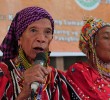by CANDICE Y. CEREZO
www.ofwjournalism.net
PASIG CITY — A DECADE after a regional property bubble burst, the country�s golf industry swings to fresh hits every summer, courtesy of moneyed Filipinos from the United States.
In three weeks last April, for instance, retired Filipinos from the US pumped a conservative estimate of P9.6 million into the economy via the golf-playing circuit.
And these were only the hundred composing the group of Ferdinand Yarra, a retired engineer for the Chicago Transit Authority, who splurged on the golf courses of their former country.
Yarra, who punched his last time card in 2006 for the federal government-run transportation system of trains and buses in Chicago, said he spent a minimum US$2,000 or its still weak peso equivalent at P48=US$1.
While the peso has gained since, Yarra and companions also funneled the money they earned in the US to the Philippines�s hotel and restaurant businesses, transportation industry �they rode hired vans, flew on domestic planes, flagged taxi cabs� and, telecommunications sector.
In the same way that money sent by temporary and contract-based Filipinos from more than 180 countries, these golfers� cash also contributed to the strengthening of the peso. After the last club-toting immigrants left, the greenback stood at a weak US$1=P46 exchange rate.
Yarra knows that Filipino retirees like him are now targeted by the local tourism business.
�We do not really have to find a way to play golf in the Philippines. Travel packages with golf as the main itinerary are being offered or marketed to us migrants in the US. And, sometimes, fellow Filipinos who manage these travel agencies that offer the service to us,� Yarra told the OFW Journalism Consortium �.
He added they acquiesce to the lure by their native country�s business.
�I�m no economist but the difference in our spending here is the per capita income: our money grows ten-fold in value when we play golf in the Philippines,� he said.
The impact to the economy, however, is felt when these Filipinos play golf in groups, which differentiates the character of this market segment five to ten years ago when the recreational sport was popularized by then-president Fidel V. Ramos.
Migrant Pinoys pushing their carts of balikbayan goodies for their relatives with golf bags in tow do not tell anything out of the ordinary �unless they come in huge groups,� Yarra said.
Birdie
THE warm air that greeted Yarra last April as he strode to a waiting taxi outside the airport solidified his belief that the Philippines remains a major hub for golf-playing immigrants with affinity to the country.
After an hour�s rest at a five-star hotel in Ortigas, Yarra�s companions meet up with another group composed of Filipino green-card holders who came from different parts of the US.
A cocktail party caps an orientation on the golf and travel tour.
�This whole trip, we really planned it. We had it all scheduled: which hotel to stay, where to go. There is an itinerary [they crafted for us] just like my [previous] trips here,� he said.
Yarra, is the eldest of nine siblings who are still in his hometown in Kidapawan City, North Cotabato, which is a two-hour land travel away from Davao where he also stopped by to play golf.
�The first group I joined was mostly composed of migrants from the states of California, New York, and Illinois. Then there was another group of migrants from Chicago that I joined when they arrived in the country a few days after we arrived. A lot of them come here by groups.�
He said more than five groups of golfers from Chicago travel to the Philippines almost at the same time.
�They are either in groups of 30, 50 to 100 people. In our local alone, we have five groups of golfers and I know most of them.�
Swing
FILIPINOS in Chicago are steeped in the game of golf ultimately because of their easy access to both private and public golf courses in their area, Yarra explained.
�Within the city or suburb alone, the most accessible for me from my house in just a few kilometers drive, would be around 200 or more available golf courses. There are �a lot of them,� Yarra said.
In the US, according to him, most public golf courses charge a player green fees of about $20 (P960 at US$1=P48) on weekdays and $30 (P1,440) on weekends. Private golf clubs, he added, charge members or sponsored non-members about $45 on weekdays and $65 on weekends.
Yarra said he would sometimes play more than three times a week at a public golf course with a price along the range of his �average or slightly average income.�
OFWS & Migration, Pinoy Life Abroad









